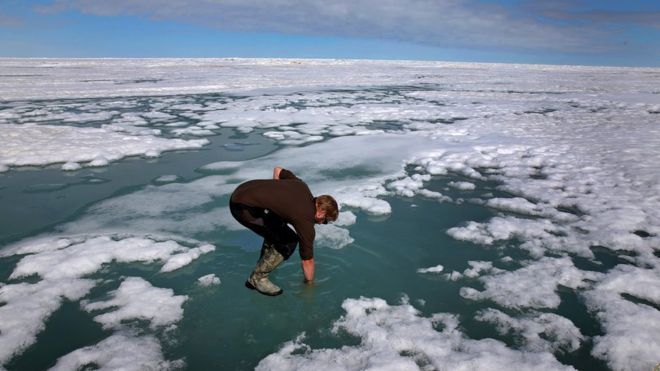 Data coming in from distinctly different sources such as NASA, NOAA and also the UK’s Met Office all now confirm that the previous warmest year ever recorded, 2015, is now in second place and that 2016 is now the warmest year ever recorded.
Data coming in from distinctly different sources such as NASA, NOAA and also the UK’s Met Office all now confirm that the previous warmest year ever recorded, 2015, is now in second place and that 2016 is now the warmest year ever recorded.
Quite rightly this is being picked up and reported by major news outlets. If you just happen to have been keeping your finger on the #climate pulse then this is not really news, it simply confirms what you already knew to be the most probable official conclusion.
So why blog about it?
Basically because I would like to point to a few bits of further detail.
Step back a bit from just the 2016 data and a rather startling story emerges. 15 of the warmest 16 years on record have now occurred since 2001.
YouTube Visuals
Sometimes a visual illustration has a far bigger impact that a page of words, and so with that thought in mind here are a couple of interest.
Let’s start with a 20 second clip from NASA Climate Change that uses a colour coded visual representation of the data we have the for each and every year starting in 1880 …
Under it they explain …
Earth’s 2016 surface temperatures were the warmest since modern record-keeping began in 1880, according to independent analyses by NASA and the National Oceanic and Atmospheric Administration (NOAA).
Globally-averaged temperatures in 2016 were 1.78 degrees Fahrenheit (0.99 degrees Celsius) warmer than the mid-20th century mean. This makes 2016 the third year in a row to set a new record for global average surface temperatures.
The 2016 temperatures continue a long-term warming trend, according to analyses by scientists at NASA’s Goddard Institute for Space Studies (GISS) in New York. NOAA scientists concur with the finding that 2016 was the warmest year on record based on separate, independent analyses of the data.
This color-coded map displays a progression of changing global surface temperatures anomalies from 1880 through 2016. The final frame represents global temperature anomalies averaged from 2012 through 2016 in degrees Celsius.
For more information and to download the visualization, visit https://svs.gsfc.nasa.gov/4546.
Next we have a clip from the Met Office – Weather. Here Alex Deakin takes you though a graph and explains it …
Provisional full-year figures for global average near-surface temperatures confirm that last year, 2016, was one of the warmest two years on record, nominally exceeding the record temperature of 2015.
But what about that El Niño event?
Yes indeed, it did contribute, but that is not the entire story. As explained by the BBC …
A number of meteorological agencies from around the world have released their figures today. They all suggest that warming in 2016 was a record that had an important contribution from El Niño.
The Met Office says it contributed about 0.2C to the annual average for 2016. However, researchers believe that while this is substantial, it is not the whole story.
“We understand the contribution El Niño makes fairly well and we’ve seen it many times,” said Prof Ellie Highwood from the University of Reading.
“But even if you take that contribution away, we would expect 2015 and 2016 to still be the warmest years we’ve seen, so a majority of it is coming from global warming and the greenhouse effect.”
NOAA – Global Analysis – Annual 2016
The full NOAA Global Analysis for 2016 can be found here. There they lay out a good summary …
With the contribution of eight consecutive high monthly temperature records set from January to August, and the remainder of the months ranking among their five warmest, 2016 became the warmest year in NOAA’s 137-year series. Remarkably, this is the third consecutive year a new global annual temperature record has been set. The average global temperature across land and ocean surface areas for 2016 was 0.94°C (1.69°F) above the 20th century average of 13.9°C (57.0°F), surpassing the previous record warmth of 2015 by 0.04°C (0.07°F). The global temperatures in 2016 were majorly influenced by strong El Niño conditions that prevailed at the beginning of the year.
This marks the fifth time in the 21st century a new record high annual temperature has been set (along with 2005, 2010, 2014, and 2015) and also marks the 40th consecutive year (since 1977) that the annual temperature has been above the 20th century average. To date, all 16 years of the 21stcentury rank among the seventeen warmest on record (1998 is currently the eighth warmest.) The five warmest years have all occurred since 2010.
Overall, the global annual temperature has increased at an average rate of 0.07°C (0.13°F) per decade since 1880 and at an average rate of 0.17°C (0.31°F) per decade since 1970.
A few rather starting additional details
The official NASA Climate Change YouTube channel has just 4,485 subscribers, and the clip above from there has been viewed just 1,404 times. The Met office does a bit better, their YouTube channel has 17,396 subscribers, but the clip itself has only been viewed 1,197 times (perhaps those numbers have increased by now)
Given that climate change is perhaps the most important 21st century challenge, and in fact may be the most important challenge our species has ever faced, those numbers are perhaps a tad discouraging.
“Climate change is one of the great challenges of the 21st Century and shows no signs of slowing down. The decarbonisation of the global economy is the ultimate goal to prevent the worst effects of climate change. The hottest year on record is such a clear warning siren that even President-elect Trump cannot ignore.“
– Prof Mark Maslin, University College London.